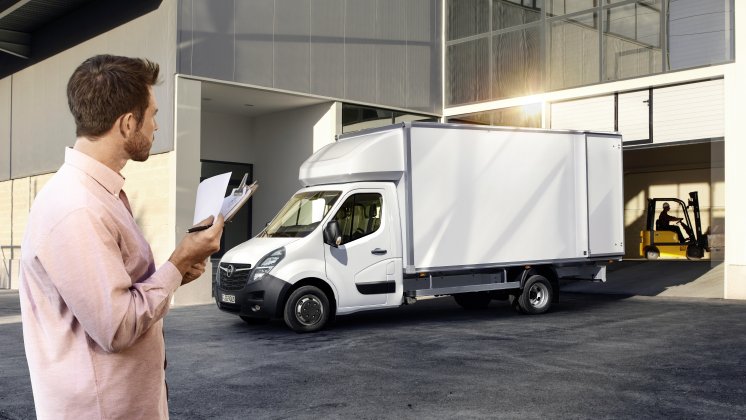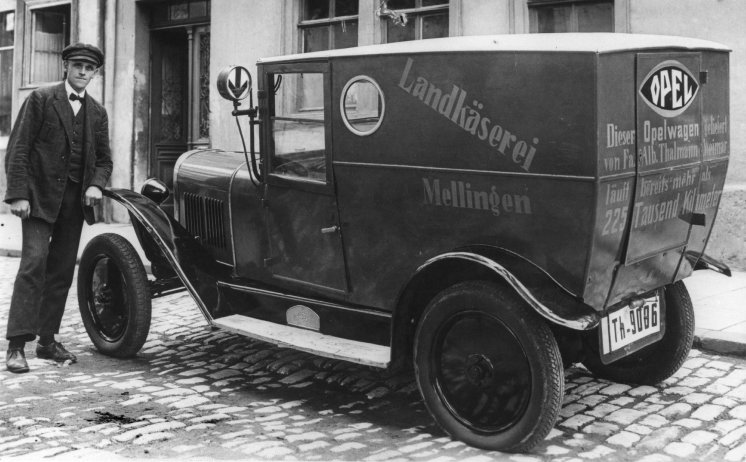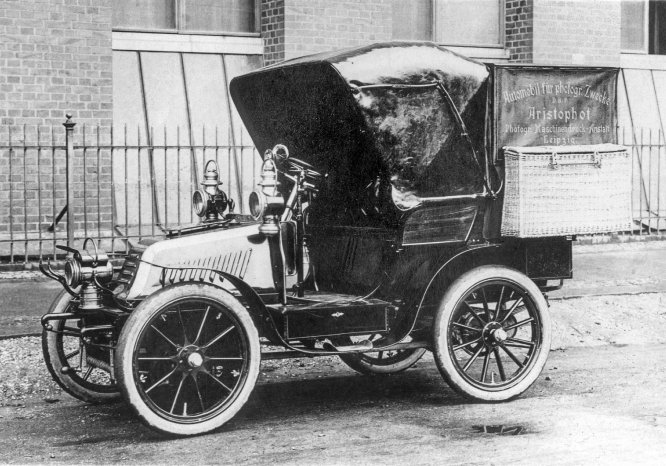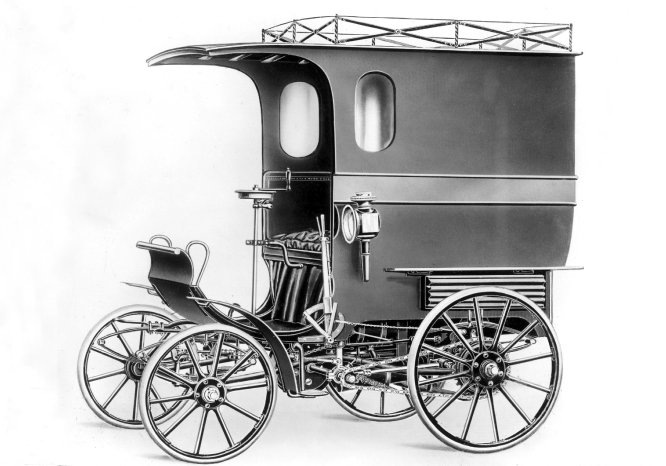- Automotive production since 1899: „System Lutzmann“-based “motor freight car”
- “Wirtschaftswunder”: Opel fast-delivery vehicles power the German economic miracle
- Powerful fleet: Opel Combo, Vivaro and Movano make sure shelves are stocked
Part 1: The Pioneering Years: the “Koloss” (giant) from Rüsselsheim
Motor cargo vehicles, company cars, delivery vans – new terms for a new era. With the advent of the automobile at the end of the 19th century, the focus of development was also on the new vehicles’ load capacity and the durability of their engines. All of a sudden, the well-being and muscle power of horses were no longer required for transport. Instead of hay from the feed trade, the automobile pioneers bought petrol in the pharmacy. After all, the invention of the petrol station was still a long way off when the Opel brothers built the first motor vehicles in Rüsselsheim in 1899. Straight away in its premiere year, the “Opel Patent MotorwagenSystem Lutzmann” formed the basis for “a giant of a motor freight car built by the local company Adam Opel for a large wine business“. This quote from the local Main-Spitze newspaper on July 2, 1899 is proof of the first Opel delivery van. What was then a “giant” would be a very light commercial vehicle today – compared to the current 40-tonne giants. The first photo of an Opel LCV thus dates from 1901 and shows the Lutzmann as a kind of luggage cart with closed body – 5 hp strong and around 20 km/h fast!
Modern times: carriages become trucks
The cargo pioneers were quickly followed by practical delivery vans: with the “System Darracq” (from 1902), Opel already showed the layout of the front engine, gearbox, propeller shaft and rear-wheel drive that is still used today. On this basis, closed delivery and eye-catching advertising vans were produced until the 1920s – mostly as single units to customer specifications. In 1924, Opel was the first German manufacturer to start assembly line production – modern times that were characterised by the 4 hp models from Rüsselsheim. Between May 1924 and June 1931, a total of 119,484 units of the legendary “Laubfrosch” (Tree Frog) were produced. Perhaps the first truly light commercial vehicle according to modern concepts was then the Opel “Dienstwagen” (company car) in 1931. The panel van with cargo capacity of 500 kilogrammes became a huge success in its class with a market share of 80 per cent. Opel built 22,000 units of the 23 hp “Dienstwagen”. Another success was the Opel Blitz “Eintonner” from 1934 – either as a platform or panel van. The small Blitz represented the entry-level model variant of Opel’s famous truck.
Part 2: the Opel “Schnelllieferwagen” (Express Delivery Van) era
Germany’s “Wirtschaftswunder” (economic miracle) is the era of the Opel “Schnelllieferwagen” (fast-delivery vehicle). The golden rule for business people is to supply customers as quickly as possible. This is exactly what was made possible by the Opel Olympia as early as 1950 and the Olympia Rekord “Schnelllieferwagen” from 1953. Thanks to their load capacity, reliability and comfortable passenger cabins, the express delivery vans – together with the Opel Blitz of the 1950s – became automotive “hits“ during the years of the economic miracle. At the same time, the Olympia Rekord established the foundation for the success story of Opel's variable caravan models (Car and Van). For the 1950s, the modern and very elegant lines of the all-steel bodywork were representative, functional and effective advertising all at the same time. The large load capacity was also impressive, including a payload of up to 515 kilogrammes.
In the early 1960s the ideal partner for craftsmen was the Opel Rekord P2. “Fast delivery van in new shape – at your service” was the promise of the Rekord P2, which it kept with large loading space, low operating costs and proverbial reliability. The P2's repertoire included two powerful and extremely robust engines with 1.5 litre displacement and 50 hp, as well as 1.7 litre displacement and 55 hp. An innovative three-speed semi-automatic gearbox called "Olymat" was also available. Between 1960 and 1963, 32,026 of the express delivery vans were built in Rüsselsheim.
The 1966 Opel Rekord C Caravan finally ignited the big estate boom. Externally, the Caravan captivated with its “Coke bottle design” shape below the windows. When it came to comfort, the five-link rear axle ensured very pleasant driving behaviour. The progressive Rekord C was also available as a pure delivery van.
Part 3:the Combo began the “raise the roof” era in the 1980s
In the 1980s, Opel realised that the concept of a car with a high roof but compact exterior dimensions was also ideal for the needs of families and outdoor-fans: the Kadett Combo was born in 1985. This first Combo differed from its van sibling by an approximately 25 cm higher loading space. The partition wall behind the seats was an example of the fact that flexibility was already a top priority with the Kadett Combo: it could be fitted with an optional net or even a door so that the loading length extended to the windscreen.
In 1993, the Combo was introduced as a separate model line. The front of the Combo B was practically identical to the Corsa, complemented by an extended wheelbase and a high, box-shaped load compartment with a volume of more than 3,100 litres.
A true “family Combo” was launched in 2001 with the Combo Tour. This variant of the Combo C came with practical stowage nets, pockets in the doors and features such as integrated cup holders. Based on the Tour, Opel even developed a sporty prototype for racing fans: the Combo “Eau Rouge“, its name a reference to the famous combination of curves on the racetrack in Spa-Francorchamps, Belgium, was powered by the Corsa GSi engine. While the “Eau Rouge” was an eye-catcher at the 2002 Paris Motor Show, the Combo Tramp, with sump-guard and 20 millimetres higher ground clearance, ensured on and off-road driving fun from 2005.
Starting in 2012, Combo D customers were the first to be able to choose between two vehicle lengths. The Combo was initially available as a five-seater with a short or long wheelbase, in normal and high roof versions, with standard sliding doors and an estate tailgate or double-wing rear doors.
Part 4: everyday heroes: Opel Combo, Vivaro and Movano
The fifth generation of the compact, multifunctional Opel Combo was launched in 2018. The innovative newcomer is available both as a passenger car – Combo Life – and as a light commercial vehicle – Combo Cargo – in many variants. Both are available as standard M (4.40 metres) or XL long versions (4.75 metres). The family van comes as a five or seven-seater with plenty of space for up to 2,693 litres of luggage. The panel van offers up to 4.4 m3 of cargo space, room for two euro pallets and can carry a payload of up to 1,000 kilogrammes. This extraordinary flexibility is made possible by the completely new architecture on which the Combo Cargo is based and by sophisticated packaging. In addition, the LCV version will also be available as a crew cab and with a roof flap in the future. Thanks to a new development approach, the fifth Combo generation offers an unrivalled wealth of innovative technologies and assistance systems in both the passenger car and LCV versions.
Third generation of successful LCV – Opel Vivaro
Since 2001, the Vivaro has built a strong reputation as a cargo carrier or office on wheels, with around one million units rolling off the assembly line. With sizes tailored to different needs, and numerous innovative technologies, the new Vivaro can perform every job better than ever before. The Vivaro offers a range tailored to customer needs – a Cargo panel van, a crew cab for up to six occupants, a platform chassis and a Combi people-carrier, plus – for the first time – three instead of two lengths (4.60 metres, 4.95m and 5.30m). With a maximum cargo capacity of 6.6 cubic metres, the new Vivaro has a payload of up to 1,400 kilogrammes – 200kg higher than its predecessor’s. The same applies to towing weights: the maximum trailer load of 2,500kg is half a tonne higher than before. Only the height is modest, with most variants measuring about 1.90m. The new Vivaro can therefore access parking in basements or shopping centres with low roofs, which makes loading and unloading easier. As of this year, there will be an all-electric Vivaro-e for emissions-free deliveries in towns. Depending on the battery, ranges of up to 230 and 330 km are possible in the WLTP1 test cycle.
One for all: the Opel Movano can do almost anything
The new Movano panel van is available in four lengths and three heights, with up to 4.5 tonnes maximum gross vehicle weight and 17 cubic metres of cargo volume. A total of 150 different body and conversion variants are offered ex works. Depending on the variant, the Movano can transport up to five euro pallets. This means that there is a Movano for almost every need. Numerous driver assistance systems make driving more relaxing and above all safer. Optimum all-round visibility is provided by the Blind Spot Warnings and a “Rear Vision” Camera system. Then there is the Navi 50 IntelliLink Pro infotainment system, which is compatible with Apple CarPlay and Android Auto and thus offers excellent connectivity. Wireless charging is also available for compatible phones. The Movano is the big LCV in Opel’s portfolio. Together with the new Vivaro and Combo Cargo, the German brand has the youngest LCV fleet on the market; a fleet that can look back on a 120-year-old tradition.
[1] Range determined according to WLTP test procedure methodology (R (EC) No. 715/2007, R (EU) No. 2017/1151). The actual range can vary under everyday conditions and depends on various factors, in particular on personal driving style, route characteristics, outside temperature, use of heating and air conditioning and thermal preconditioning.






